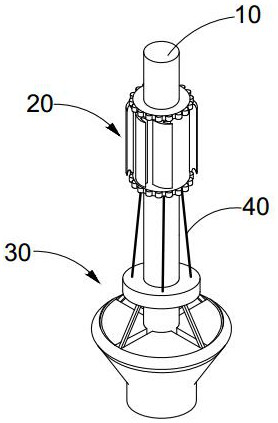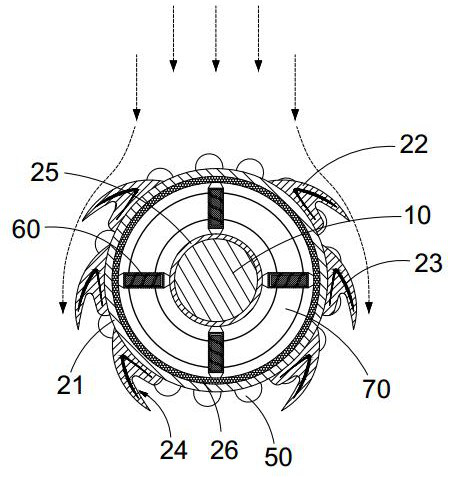Sea-crossing bridge pier anti-collision buffer device
A buffer device and anti-collision technology, which is applied in bridges, bridge parts, bridge construction, etc., can solve problems such as difficulty in automation, loss of life and property, and unfavorable bridge pier protection
- Summary
- Abstract
- Description
- Claims
- Application Information
AI Technical Summary
Problems solved by technology
Method used
Image
Examples
Embodiment 1
[0031] See attached Figure 1-7 As shown, the anti-collision buffer device of cross-sea bridge pier includes:
[0032] The first anti-collision component 20 is sleeved on the pier 10 and the first anti-collision component 20 can move up and down relative to the pier 10;
[0033] The second anti-collision component 30 is sleeved on the pier 10, the second anti-collision component 30 is arranged under the first anti-collision component 20, and the second anti-collision component 20 can move up and down relative to the pier 10. The second anti-collision component 30 and the first anti-collision component 20 are connected by a steel rope 40;
[0034] Among them, the first anti-collision assembly 20 includes a protective washer 25 sleeved on the outside of the pier 10, the inner wall of the protective washer 25 and the outer wall of the pier 10 have a gap, the outer side of the protective washer 25 is provided with a main ring sleeve 21, the inner wall of the main ring sleeve 21 A coaxi...
Embodiment 2
[0044] This embodiment is further improved on the basis of embodiment 1 as follows: see appendix Figure 8 As shown, the back surface of the bridge pier 10 is provided with an auxiliary support 82. The auxiliary support 82 is vertically arranged and adjacent to the back surface of the pier. The auxiliary support 82 is a second rectangular frame perpendicular to the two sides of the rectangular frame. The rectangular frame is connected with a third rectangular frame 81, the third rectangular frame 81 and the second rectangular frame have an included angle, the auxiliary support 82, the second rectangular frame, and the third rectangular frame 81 are provided with mesh 82, A rotating shaft is connected between the two rectangular frames, and water guide plates 83 are evenly distributed on the surface of the rotating shaft. By designing the auxiliary support 82 on the back water surface of the bridge pier to provide auxiliary support after the pier 10 collides, the mesh 82 designed...
Embodiment 3
[0046] In this example, the first collision avoidance component 20 is modeled and numerically simulated, such as Picture 10 As shown, the first anti-collision component 20 absorbs the collision force through the deformation of the first buffer plate 22 on the main ring sleeve 21 and generates a corresponding rotation after being impacted. It can be seen that the stress on the bridge pier is small, and the first anti-collision The component 20 can change its structure to absorb impact energy when a collision occurs.
[0047] It should be noted that the maximum collision energy generated by the collision can be calculated according to the limited ship tonnage and speed in the relevant regulations of water navigation management, and then the first and second anti-collision components are parameterized according to the maximum collision energy. The optimization enables the anti-collision component to absorb most of the collision energy, and the pier 10 can be protected by the anti-co...
PUM
 Login to View More
Login to View More Abstract
Description
Claims
Application Information
 Login to View More
Login to View More - R&D
- Intellectual Property
- Life Sciences
- Materials
- Tech Scout
- Unparalleled Data Quality
- Higher Quality Content
- 60% Fewer Hallucinations
Browse by: Latest US Patents, China's latest patents, Technical Efficacy Thesaurus, Application Domain, Technology Topic, Popular Technical Reports.
© 2025 PatSnap. All rights reserved.Legal|Privacy policy|Modern Slavery Act Transparency Statement|Sitemap|About US| Contact US: help@patsnap.com



